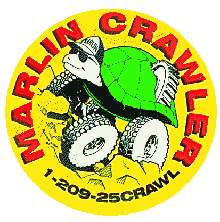

Marlin Crawler: Cheap Tricks
Visitor: 

Here are some cheap tricks and tips I've found with
my Marlin Crawler transfer case:

A Marlin Ultimate Crawler
(#263) consists of a dual transfer case in which a 4.70:1 gear is
installed in the rear transfer case. The front transfer case reduction
unit (or crawl box) retains the stock 2.28:1 low ratio. The front crawl
box is sandwiched between the transmission and the actual transfer case
and it is 6.5" long. Only the high-low gear range is retained in
the crawl box, the front drive part is removed. With the dual case, the
front drive shaft is lengthened 6.5", which allows for longer
wheel travel. In the rear, the shaft is shortened by the same amount.
With a dual transfer case, you effectively have a 4-speed transfer case
(see table below) and you gain a 2-Lo range (without having to unlock
the front hubs) by putting the crawler box into low and shifting the
transfer case between 4H and 2H.
With a Marlin Ultimate Crawler (dual transfer case), 5.29:1 R&P
gears, overall crawl ratios work out to:
Final Drive Ratios (lower-than-stock)
Front |
Rear |
1st |
2nd |
3rd |
4th |
5th |
1.00:1 |
1.00:1 |
20.9 |
11.3 |
7.3 |
5.3 |
4.5 |
2.28:1 |
1.00:1 |
47.7 |
25.8 |
16.7 |
12.1 |
10.2 |
1.00:1 |
4.70:1 |
98.3 |
53.2 |
34.4 |
24.9 |
21.1 |
2.28:1 |
4.70:1 |
224.1 |
121.4 |
78.5 |
56.7 |
48.1 |
To put this in perspective, take a typical engine idle speed of 800 RPM
and using 33" tires with the above gearing, your speed is
about 29 feet/minute, or less than 1/3 MPH!
A few things I've noticed about driving with a Marlin Crawler:
-
With the 4.70 gears engaged, there is much more play in the drive line.
I find it most noticeable in rocky, flat trails where the engine
alternately switches from driving to braking the wheels. I imagine some
of this comes from the Detroit lockers I have, a 200K+ driveshaft, but
it is *worse* in 4.70 than in 2.28 range.
-
In any situation where you are going down drop-offs, I find riding the
brake as the wheels go over drop off is crucial. Otherwise, there seems
to be a moment of free fall as the driveline unloads then re-tensions
on a new tire. This too, is partly due to free-play in my lockers, but
it is worse in 4.70 than in 2.28 gear.
-
Nice thing now is that in low-low-1st, no amount of braking can kill
the engine!
-
A stock dual transfer case would be an alternative to this problem as
you would get a low-low range of 5.19:1 and a 108 crawl ratio (w/
5.29s).
-
I imagine my engine and transmission mounts are a bit sloppy (200K+ on
the originals), so I'll be replacing those shortly and probably will
use mounts on both the crawl box and transfer case like Jay Kopycinski
did.
-
The 4.70 gears are noisier than the 2.28 gears. There is a distinct
whine that sounds kind of like a turbo.
-
With my 22RE engine, I find it will stall in low-low-2nd gear at idle
(121:1) but will not stall in low-low-1st, even up a steep hill w/
brakes applied (why is this important? - see below).
-
I can now get the front TrueTrac differential to lock up using brake
biasing.
-
The TrueTrac is a gear driven limited slip differential, not a true locker.
It functions by the internal worm gears binding up and transferring
torque between the wheels before spinning begins. The TT has a transfer
ratio of ~3:1, meaning up to 3x the torque on the slipping wheel can be
transferred to the gripping wheel. This is fine until a wheel is in the
air (when 3x nothing is still nothing!). To compensate for this, brake
drag can be applied to mimic grip, thereby transferring torque to the
wheel with grip. In practice with my 22RE and stock gears, I found
adding brake drag while crawling up a steep hill would simply kill the
engine.
-
Now its all different. On the Toy4x4 Rubicon '98 trip at the top of
Cadillac Hill, I was crossed up with the rear diff. hung up on a rock.
I had three wheels spinning (including the front wheel in the air).
Letting the engine idle in low-low-1st gear, I began applying brake
pressure and the vehicle slowly started inching forward, pulled along
by the front wheel that was on the ground. It is a weird sensation to
start moving by hitting the brakes! Granted, if I had a true front
locker, I wouldn't have been hung up in that situation, but the
TrueTrac is *so* nice in the snow, that this quirk is worth living
with.
-
I find that I can only get this technique to work if I'm below about
75:1 crawl ratio, at least when climbing steep hills. What I find is
that I end up killing the engine with the extra brake drag, when it is
nearly bogged down due to the steepness of the hill. As I begin
applying brake drag, once the front wheel with traction begins taking
torque, that will stall the engine. At 75:1, I've got barely enough
torque to handle the vehicle load plus the brake drag.
-
I find that the Marlin gears have helped my driving in stock low range
as well. I find I have a much better feel of the throttle and engine
response and can now idle/crawl through stuff I once would have had
trouble with. In fact on a recent trail run, I used 4.70 gears going in
and 2.28 coming out. Granted I did stall a few times coming out, but it
otherwise felt comfortable and in control.
-
I've learned that the 22RE engine speed is fairly stable below aboout
1200 and above 2500 RPM. In between those speeds, I find it tends to
surge when the load is decreased, such as when you drive up and over a
rock (high load up, low load down). Therefore, try to pick a gear to
stay in one of those RPM ranges. With 20 forward gears, there is always
one or two to choose from.

With such extreme low gearing, a few cautions must be exercised:
-
Engine torque can be multiplied nearly 5 times over stock. Combined
with traction-aiding differentials, this can result in all this torque
ending up on one axle. In low range I try to stay off the gas and let
the engine idle whenever possible. Afterall, the reason you are in the
low gear is to go slow, SO GO SLOW!
-
Combine a lower than stock differential ratio with much lower than
stock transfer case gearing and you have a potential problem when out
of gear. If you try to coast with the clutch disengaged, it can be
exposed to extremely high RPMs at even slow speeds. Even at just 3 MPH
in low range, the clutch will be spinning at around 8000 RPM, which is
enough to cause it to disintegrate.
-
I found my crawler gears to be much tougher to shift than my old gears.
-
After a few thousand mile breakin and changing to some nice synthetic
gear oil, made them shift much smoother.
-
Note, that shifting in and out of the 4.70 : 1 gear requires a full
stop in most cases.
-
The 2.28 : 1 gear can actually be used with judicious double-clutching.
-
Also, the 4WD shift-on-the-fly feature only works if you have the front
hubs engaged. I thought I had lost that capability after the Marlin
gears went in, but I had the front hubs unlocked.
-
I notice the 4.70 : 1 gears have a lot of slop. This is most
apparent when you are on undulating terrain and alternating between
driving and braking. For level and downhills, I try to stay out of the
lowest ranges for better control.
-
I found another Marlin low use, that is crawling in deep snow. It seems
that if you turn the wheels slow enough to allow the snow to compact,
you can go in deeper, softer snow than you can by churning through
whith faster wheel speeds. At 98:1 I was getting farther than I could
at 48:1, but at 224:1, I just floated over the powder.

After about a 5000 mile break-in period, I decided it was time to
change the lube to the Marlin cases. I opted to use 75-90W Mobil-1
synthetic gear oil. Those dual cases seems to really heat up with the
mineral oil, the slicker oil seems to help out some. Also, with the
added friction of the second case, I found that I picked up 1 MPG or so
after changing to the synthetic oil.
So, upon close examination of a Marlin Crawler dual transfer case, I
noticed there are two drain plugs but only one fill plug, (on the stock
transfer case). It turns out the crawl box shares the same gear oil
with the transfer case. To change the gear oil in this setup involves
the following steps:
-
Warm up the transfer cases;
-
A 10-20 mile drive should do it.
-
Remove the fill plug and both drain plugs (one at a time unless you
have a large drain pan).
-
If the plug on the crawl box is not drained, about a cup of old gear
oil will remain there.
-
Replace both drain plugs and fill both gear boxes through the rear fill
plug (GL/5 grade oil).
-
Total gear oil required is approx. 1.7 qts. for the transfer case and
0.7 qts. for the crawl box.
-
Wait 5-10 minutes after the initial fill and top off the oil as needed.
-
For a proper fill, this should be done on level ground.
Rating:
 /2
/2
[back to the top]

 ===>>
===>> 

Last updated: 04.MAR.1999

![]()
![]()
![]()
![]()
![]()
/2

![]()